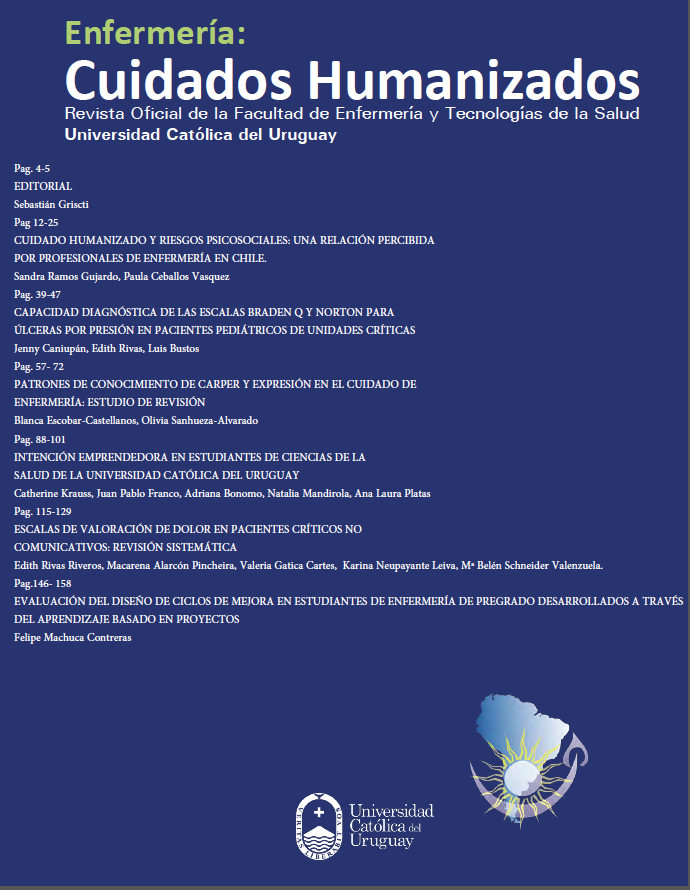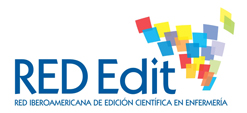Diagnostic capacity of the Braden Q and Norton Scales for pressure ulcers in pediatric patients of critical units
DOI:
https://doi.org/10.22235/ech.v7i1.1539Keywords:
Scales, Pressure Ulcer, Pediatric Intensive Care Units, Pediatric nursesAbstract
The objective of the investigation was to evaluate the diagnostic capacity of the Braden Q and Norton scales for the development of pressure ulcers in pediatric patients of Critical Units in a highly complex hospital in Chile. It is a cross-sectional study comparing diagnostic tests in patients admitted to critical units. The sample was non-probabilistic, for the convenience of 118 children. Both scales were analyzed respecting the precepts, in order to compare the discriminative capacity of two diagnostic tests verifying that both are measured simultaneously while applied on the same subjects. The research was approved by the Ethics Committee, Health Service and Informed Consent signed by the parents of the children. It was determined that the sensitivity of the Braden Q scale, at 24 and 48 hours, is lower than Norton´s in the same evaluations; it has a higher positive predictive value in both measurements, as well as the probability ratio (+). It is concluded that Braden Q is the ideal scale to assess the risk of developing pressure ulcers in the pediatric population; it presents greater reliability.
Downloads
References
2. Kottner J, Wilborn D, Dassen T. Frequency of pressure ulcers in the paediatric population: A literature review and new empirical data. International Journal of Nursing Studies. 2010; [citado 14 Ene 2015]; 47(10):1330–1340 Disponible en: http://www.sciencedirect.com/science/article/pii/S0020748910002178
3. Pancorbo-Hidalgo P, García-Fernández F, Torra i Bou J, Verdú J, Soldevilla-Agreda J. Epidemiología de las úlceras por presión en España en 2013: 4º Estudio Nacional de Prevalencia. Gerokomos [Internet]. 2014 [citado 13 May 2016]; 25(4): 162-170. Disponible en: http://scielo.isciii.es/scielo.php?script=sci_arttext&pid=S1134928X2014000400006
4. Díaz de Durana-Santa S, Ayllon N, Latorre K. Evolución de la incidencia de las úlceras por presión tras la mejora de un protocolo de prevención en cuidados intensivos. Gerokomos [Internet]. 2008 Dic [citado 13 May 2016]; 19 (4): 55-60. Disponible en:
http://scielo.isciii.es/scielo.php?script=sci_arttext&pid=S1134-928X2008000400007
5. Drake D, Swanson M, Baker G, Pokorny M, Rose MA, Clark-Reed L, et al. The Association of BMI and Braden Total Score on the Occurrence of Pressure Ulcers, Journal of Wound, Ostomy & Continence Nursing. 2010 [citado 12 Ene 2015]; 37(4):367–371. Disponible en: http://journals.lww.com/jwocnonline/Abstract/2010/07000/The_Association_of_BMI_and_Braden_Total_Score_on.5.aspx
6. Noonan C, Quigley S, Curley M. Using the Braden Q Scale to Predict Pressure Ulcer Risk in Pediatric Patients. J Pediatr Nurs.. 2011 [citado 14 Nov 2015]; 26 (6).566-75. [Disponible en: http://www.sciencedirect.com/science/article/pii/S0882596310002319
7. Pancorbo P, García F, Soldevilla J, Martínez F. Valoración del riesgo de desarrollar úlceras por presión: uso clínico en España y metaanálisis de la efectividad de las escalas. Gerokomos [revista en Internet]. 2008 Jun [citado 22 Abr 2015]; 19(2): 40-54. Disponible en: http://scielo.isciii.es/scielo.php?pid=S1134-928X2008000200005&script=sci_arttext
8. Hospital Hernán Henríquez Aravena. Valoración, Prevención y Notificación de úlceras por presión (UPP). Documentos web. Disponible en: file:///E:/Perfil%202014/Desktop/PUBLI%20JULIO%202016/Prevencion_y_notificacion_de_ulceras_por_presion_upp.pdf
9. García F, Pancorbo P, Soldevilla J. Escalas de valoración del riesgo de desarrollar úlceras por presión en la infancia. Gerokomos [Internet]. 2001 [citado 13 Sep 2015]; 22 (1): 26-34. Disponible en: http://scielo.isciii.es/pdf/geroko/v22n1/helcos1.pdf
10. Curley M, Razmus I, Roberts K, Wypij D. Predicting Pressure Ulcer Risk in Pediatric Patients: The Braden Q Scale. Nursing Research. 2003 [citado 10 Nov 2015]; 52(1):22-33. Disponible en: http://journals.lww.com/nursingresearchonline/Abstract/2003/01000/Predicting_Pressure_Ulcer_Risk_in_Pediatric.4.aspx
11. Blumel J, Tirado K, Schiele C, Schönffeldt G, Sarrá S. Validez de la Escala de Braden para predecir úlceras por presión en población femenina. Rev Méd de Chile [Internet] 2004 [citado 24 Sep 2015]; 132 (5): 595-600. Disponible en:
http://www.scielo.cl/scielo.php?script=sci_arttext&pid=S0034-98872004000500009
12. Duffau G. Tamaño muestral en estudios sobre pruebas diagnósticas. Rev. Chil. Pediatr. 1998; 69(3):122-125. [citado 23 May 2015]. Disponible en: http://www.scielo.cl/scielo.php?script=sci_arttext&pid=S037041061998000300008
13. Emanuel E. ¿Qué hace que la investigación sea ética? Siete requisitos éticos. OPS/OMS. Serie Publicaciones 1999: Investigación en sujetos humanos: Experiencia Internacional [citado 01 Dic 2015] 33–46. Disponible en: http://www.bioetica.edu.uy/actividades/cbcc6/requisitos_eticos_para_la_investigacion.pdf
14. McLane K, Bookout K, McCord S, McCain J, Jefferson L. The 2003 National Pediatric Pressure Ulcer and Skin Breakdown Prevalence Survey: A Multisite Study. Journal of Wound, Ostomy & Continence Nursing: 2004 [citado 12 Ene 2015]; 31(4): 168–178 Disponible en: http://journals.lww.com/jwocnonline/Abstract/2004/07000/The_2003_National_Pediatric_Pressure_Ulcer_and.4.aspx
15. Curley M, Razmus I, Roberts K, Wypij D. Predicting Pressure Ulcer Risk in Pediatric Patients: The Braden Q Scale. Nursing Research [Revista en Internet] 2003 January/February [citado 10 Nov 2015]; 52 (1): 22-33. Disponible en: http://journals.lww.com/nursingresearchonline/Abstract/2003/01000/Predicting_Pressure_Ulcer_Risk_in_Pediatric.4.aspx
16. Solis M, Krouskop T, Trainer N, Marburger R. Supine interface pressure in children. Arch Pys Med Rehab. 1988[citado 10 Nov 2015]; 69: 7-12. http://www.ncbi.nlm.nih.gov/pmc/articles/PMC2541103/
17. McCord S, McElvain V, Sachdeva R, Schwartz P, Jefferson L. Risk Factors Associated With Pressure Ulcers in the Pediatric Intensive Care Unit. J Wound Ostomy Continence Nurs. 2004 [citado 14 Ene 2015]; 31 (4): 179-183. http://www.ncbi.nlm.nih.gov/pubmed/15851859
18. Quesada C, Iruretagoyena ML, González RM, Hernández JM, Ruiz de Ocenda MJ, Garitano B et al. Validación de una escala de valoración del riesgo de úlceras por presión en niños hospitalizados. Investigación Comisionada. Vitoria-Gasteiz. Departamento de Sanidad y Consumo. Gobierno Vasco, 2009. Informe nº: Osteba D-09-08.
19. Šáteková L, Žiaková K, Zeleníková R. Predictive Validity Of The Braden Scale, Norton Scale And Waterlow Scale In Slovak Republic, Cent Eur J Nurs Midw 2015;6 (3):283–290.
20. Moore ZEH, Cowman S. Risk assessment tools for the prevention of pressure ulcers (Review).This is a reprint of a Cochrane review, prepared and maintained by The Cochrane Collaboration and published in The Cochrane Library 2014;2.
21. García F, Pancorbo P, Soldevilla J. Escalas de valoración del riesgo de desarrollar úlceras por presión en la infancia. GEROKOMOS 2015; 22 (1): 26-34.
Downloads
Published
How to Cite
Issue
Section
License
Copyright (c) 2018 Enfermería: Cuidados Humanizados

This work is licensed under a Creative Commons Attribution 4.0 International License.

















